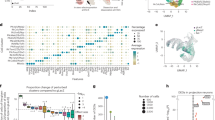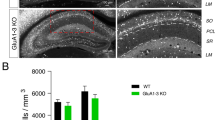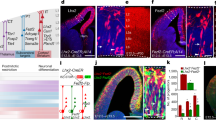Abstract
Most neurons in vertebrates make a developmental choice between two principal neurotransmitter phenotypes (glutamatergic versus GABAergic). Here we show that the homeobox gene Lbx1 determines a GABAergic cell fate in the dorsal spinal cord at early embryonic stages. In Lbx1−/− mice, the presumptive GABAergic neurons are transformed into glutamatergic cells. Furthermore, overexpression of Lbx1 in the chick spinal cord is sufficient to induce GABAergic differentiation. Paradoxically, Lbx1 is also expressed in glutamatergic neurons. We previously reported that the homeobox genes Tlx1 and Tlx3 determine glutamatergic cell fate. Here we show that impaired glutamatergic differentiation, observed in Tlx3−/− mice, is restored in Tlx3−/−Lbx1−/− mice. These genetic studies suggest that Lbx1 expression defines a basal GABAergic differentiation state, and Tlx3 acts to antagonize Lbx1 to promote glutamatergic differentiation.
This is a preview of subscription content, access via your institution
Access options
Subscribe to this journal
Receive 12 print issues and online access
$209.00 per year
only $17.42 per issue
Buy this article
- Purchase on Springer Link
- Instant access to full article PDF
Prices may be subject to local taxes which are calculated during checkout






Similar content being viewed by others

Change history
21 November 2005
This article contained a misspelling. Lhx1/2 should have read Lhx1/5 throughout the text. The PDF version of this article was corrected on 21 November 2005. Please see the PDF for details.
Notes
*This article contained a misspelling. Lhx1/2 should have read Lhx1/5 throughout the text. The PDF version of this article was corrected on 21 November 2005. Please see the PDF for details.
References
Gardner, E.J., Martin, J.H. & Jessell, T. The bodily senses. in Principles of Neural Science (eds. Kandel, E.R., Schwartz, J.H. & Jessell, T.M.) 430–450 (McGraw-Hill, 2000).
Craig, A.D. Pain mechanisms: labeled lines versus convergence in central processing. Annu. Rev. Neurosci. 26, 1–30 (2003).
Polgar, E., Fowler, J.H., McGill, M.M. & Todd, A.J. The types of neuron which contain protein kinase C gamma in rat spinal cord. Brain Res. 833, 71–80 (1999).
Azkue, J.J. et al. Glutamate-like immunoreactivity in ascending spinofugal afferents to the rat periaqueductal grey. Brain Res. 790, 74–81 (1998).
Lu, Y. & Perl, E.R. A specific inhibitory pathway between substantia gelatinosa neurons receiving direct C-fiber input. J. Neurosci. 23, 8752–8758 (2003).
Lu, Y. & Perl, E.R. Modular organization of excitatory circuits between neurons of the spinal superficial dorsal horn (laminae I and II). J. Neurosci. 25, 3900–3907 (2005).
Melzack, R. & Wall, P.D. Pain mechanisms: a new theory. Science 150, 971–979 (1965).
Malcangio, M. & Bowery, N.G. GABA and its receptors in the spinal cord. Trends Pharmacol. Sci. 17, 457–462 (1996).
Kerchner, G.A., Wang, G.D., Qiu, C.S., Huettner, J.E. & Zhuo, M. Direct presynaptic regulation of GABA/glycine release by kainate receptors in the dorsal horn: an ionotropic mechanism. Neuron 32, 477–488 (2001).
Dickenson, A.H. Gate control theory of pain stands the test of time. Br. J. Anaesth. 88, 755–757 (2002).
Scholz, J. & Woolf, C.J. Can we conquer pain? Nat. Neurosci. 5 (suppl.), 1062–1067 (2002).
Fitzgerald, M. The development of nociceptive circuits. Nat. Rev. Neurosci. 6, 507–520 (2005).
Cheng, L. et al. Tlx3 and Tlx1 are post-mitotic selector genes determining glutamatergic over GABAergic cell fates. Nat. Neurosci. 7, 510–517 (2004).
Schuurmans, C. et al. Sequential phases of cortical specification involve Neurogenin-dependent and -independent pathways. EMBO J. 23, 2892–2902 (2004).
Panganiban, G. & Rubenstein, J.L. Developmental functions of the Distal-less/Dlx homeobox genes. Development 129, 4371–4386 (2002).
Hoshino, M. et al. Ptf1a, a bHLH transcriptional gene, defines GABAergic neuronal fates in cerebellum. Neuron 47, 201–213 (2005).
Gross, M.K., Dottori, M. & Goulding, M. Lbx1 specifies somatosensory association interneurons in the dorsal spinal cord. Neuron 34, 535–549 (2002).
Muller, T. et al. The homeodomain factor Lbx1 distinguishes two major programs of neuronal differentiation in the dorsal spinal cord. Neuron 34, 551–562 (2002).
Kruger, M., Schafer, K. & Braun, T. The homeobox containing gene Lbx1 is required for correct dorsal-ventral patterning of the neural tube. J. Neurochem. 82, 774–782 (2002).
Muller, T. et al. The bHLH factor Olig3 coordinates the specification of dorsal neurons in the spinal cord. Genes Dev. 19, 733–743 (2005).
Erlander, M.G., Tillakaratne, N.J., Feldblum, S., Patel, N. & Tobin, A.J. Two genes encode distinct glutamate decarboxylases. Neuron 7, 91–100 (1991).
McIntire, S.L., Reimer, R.J., Schuske, K., Edwards, R.H. & Jorgensen, E.M. Identification and characterization of the vesicular GABA transporter. Nature 389, 870–876 (1997).
Fremeau, R.T. Jr. et al. The expression of vesicular glutamate transporters defines two classes of excitatory synapse. Neuron 31, 247–260 (2001).
Qian, Y., Shirasawa, S., Chen, C.L., Cheng, L. & Ma, Q. Proper development of relay somatic sensory neurons and D2/D4 interneurons requires homeobox genes Rnx/Tlx-3 and Tlx-1. Genes Dev. 16, 1220–1233 (2002).
Stein, R., Mori, N., Matthews, K., Lo, L.-C. & Anderson, D.J. The NGF-inducible SCG10 mRNA encodes a novel membrane-bound protein present in growth cones and abundant in developing neurons. Neuron 1, 463–476 (1988).
Logan, C., Wingate, R.J., McKay, I.J. & Lumsden, A. Tlx-1 and Tlx-3 homeobox gene expression in cranial sensory ganglia and hindbrain of the chick embryo: markers of patterned connectivity. J. Neurosci. 18, 5389–5402 (1998).
Caspary, T. & Anderson, K.V. Patterning cell types in the dorsal spinal cord: what the mouse mutants say. Nat. Rev. Neurosci. 4, 289–297 (2003).
Goulding, M., Lanuza, G., Sapir, T. & Narayan, S. The formation of sensorimotor circuits. Curr. Opin. Neurobiol. 12, 508–515 (2002).
Helms, A.W. & Johnson, J.E. Specification of dorsal spinal cord interneurons. Curr. Opin. Neurobiol. 13, 42–49 (2003).
Borodinsky, L.N. et al. Activity-dependent homeostatic specification of transmitter expression in embryonic neurons. Nature 429, 523–530 (2004).
Schaffner, A.E., Behar, T., Nadi, S., Smallwood, V. & Barker, J.L. Quantitative analysis of transient GABA expression in embryonic and early postnatal rat spinal cord neurons. Brain Res. Dev. Brain Res. 72, 265–276 (1993).
Somogyi, R., Wen, X., Ma, W. & Barker, J.L. Developmental kinetics of GAD family mRNAs parallel neurogenesis in the rat spinal cord. J. Neurosci. 15, 2575–2591 (1995).
Gross, M.K. et al. Lbx1 is required for muscle precursor migration along a lateral pathway into the limb. Development 127, 413–424 (2000).
Shirasawa, S. et al. Rnx deficiency results in congenital central hypoventilation. Nat. Genet. 24, 287–290 (2000).
Birren, S.J., Lo, L.C. & Anderson, D.J. Sympathetic neurons undergo a developmental switch in trophic dependence. Development 119, 597–610 (1993).
Chen, Z.F. et al. The paired homeodomain protein DRG11 is required for the projection of cutaneous sensory afferent fibers to the dorsal spinal cord. Neuron 31, 59–73 (2001).
Morgan, B.A. & Fekete, D.M. Manipulating gene expression with replication-competent retroviruses. in Methods in Avian Embryology Vol. 51 (ed. Bronner-Fraser, M.E.) 185–218 (Academic, San Diego, 1996).
Acknowledgements
We thank J. Johnson, D. Rowitch, R. Puettmann-Holgado and F. Yang for critical comments on the manuscript. We dedicate this work to the memory of S. Korsmeyer, in whose laboratory the Tlx gene mutant mice were made. Q.M. is a Claudia Adams Barr Scholar and a Pew Scholar in Biomedical Sciences. This work is supported by grants from the US National Institutes of Health to Q.M. and M.G.
Author information
Authors and Affiliations
Corresponding author
Ethics declarations
Competing interests
The authors declare no competing financial interests.
Supplementary information
Supplementary Fig. 1
Neurotransmitter phenotypes of the dorsal spinal cord neurons at embryonic stages. (PDF 1093 kb)
Supplementary Fig. 2
Tlx3 antagonizes Lbx1 to promote the glutamatergic cell fate. (PDF 185 kb)
Rights and permissions
About this article
Cite this article
Cheng, L., Samad, O., Xu, Y. et al. Lbx1 and Tlx3 are opposing switches in determining GABAergic versus glutamatergic transmitter phenotypes. Nat Neurosci 8, 1510–1515 (2005). https://doi.org/10.1038/nn1569
Received:
Accepted:
Published:
Issue Date:
DOI: https://doi.org/10.1038/nn1569
This article is cited by
-
Molecular analyses of zebrafish V0v spinal interneurons and identification of transcriptional regulators downstream of Evx1 and Evx2 in these cells
Neural Development (2023)
-
Analyses of binding partners and functional domains for the developmentally essential protein Hmx3a/HMX3
Scientific Reports (2023)
-
Endoplasmic Reticulum in Metaplasticity: From Information Processing to Synaptic Proteostasis
Molecular Neurobiology (2022)
-
Injured adult motor and sensory axons regenerate into appropriate organotypic domains of neural progenitor grafts
Nature Communications (2018)
-
Lmx1b is required for the glutamatergic fates of a subset of spinal cord neurons
Neural Development (2016)


